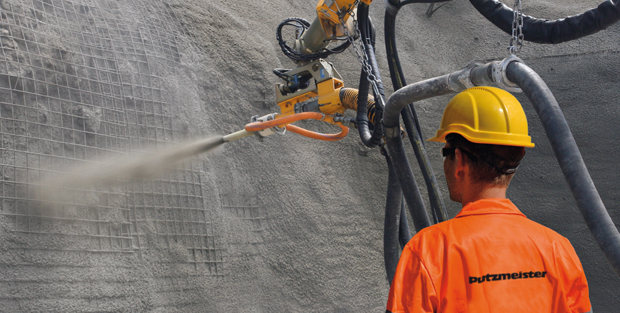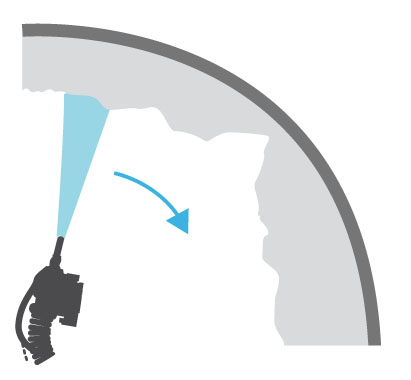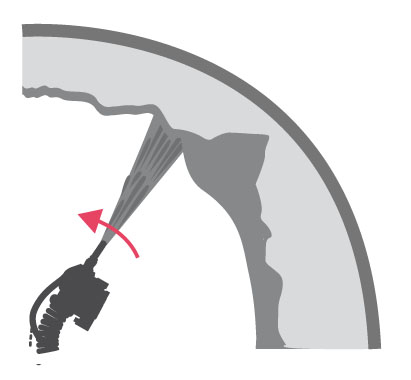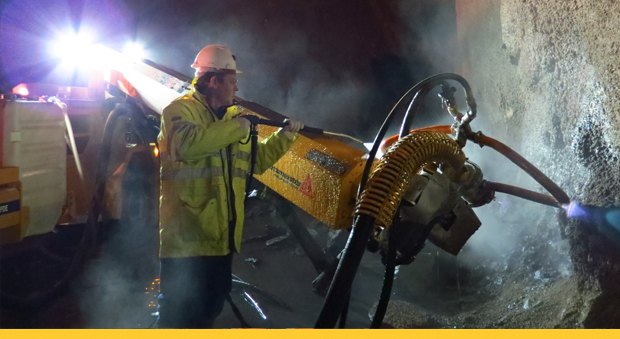The most important prerequisite for obtaining optimal results in concrete spraying is the correct mix design. The shotcrete components (aggregates, cement, water, fine material, chemical additives and fibers) form a complex system which determines the quality of the finish.
Another key aspect is the correct application technique, which is critical to ensure the adhesion of the shotcrete to the surface and minimize rebound.
Observance of the following rules helps to achieve the best possible results and maximum operator safety.
1. Clean the surface before spraying
In order to prepare the substrate in underground applications, the first step is to evaluate the risk of falling rock and loose material. All loose material and debris has to be removed, and the substrate has to be cleaned from dust, using water, air or a combination of both.
2. Maintain a distance of 1 to 2 m between the nozzle and the substrate
The impact force which guarantees the adhesion of the shotcrete to the surface is determined by the distance between the nozzle and the substrate. A distance too short results in a high quantity of rebound. With a distance too great, the impact force is too weak to provide proper adhesion and compaction of the shotcrete.
3. Place the nozzle at an angle of 90° to the substrate
The angle between the nozzle and the substrate influences the correct compaction of the shotcrete and the quantity of rebound. Besides, the spraying has to be carried out in circular movements evenly over the whole surface to achieve a homogenous result.
4. Fill holes and cracks
Before applying the first layers, it is necessary to even out the substrate by filling holes and cracks of the terrain.
5. Application in layers
Layers should be applied beginning from the bottom of the surface continuing upwards. The first layer serves as excavation support and as adhesive bridge for the following layers . The number and thickness of the remaining layers depend on the jobsite requirements and the desired homogeneity of the finish.
6. Clean the surface after longer breaks between the application of layers
If too much time between the application of one layer and another one passes, it is recommendable to clean the surface with water, air or both, in order to eliminate dust and to facilitate adhesion to the surface.
7. Clean the concrete spraying machine immediately after the application
An essential part of the correct maintenance and cleaning of the equipment is preventing any accumulation of material in the hoses, nozzle, concrete pump and additive pump to avoid an increased discontinuity of the flow and guarantee smooth operation. The application can only begin anew with properly cleaned equipment.
8. Hydrate the surface
EFNARC recommends maintaining the surface moist for at least 7 days after the application, in order to prevent loss of compressive strength and the appearance of cracks caused by the fast hardening of the sprayed concrete. This process is called curing.
Methods include the sprinkling or spraying of water over the surface, the use of paper or plastic covers and sheets or adding specific additives to the concrete mix.
9. Continuous operator training
The operator will achieve the best results of the application if kept up to date about all details concerning shotcrete: efficient use of concrete spraying equipment, correct shotcrete mixture (composition, preparation and application) and spraying techniques.
Putzmeister offers operator training with our mechanized equipment in our facilities or onsite. It is also possible to acquire the EFNARC Nozzlemen certification through our examiners.
Sources:
Dipl.-Ing. Jürgen Höfler, Dipl.-Ing HTL Jürg Schlumpf, Dipl.-Ing FH Markus Jahn, Sika Sprayed Concrete Handbook (Switzerland, 2011)
EFNARC, European Specification for Sprayed Concrete Guidelines for Specifiers and Contractors (UK, 1999)
Sergio Gracía Guzmán, Shotcrete – Guía Chilena del Hormigón Proyectado (Chile, 2014)












